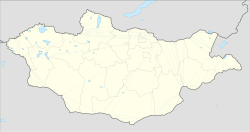| Tövkhön Monastery Төвхөн хийд | |
|---|---|
 Tövkhön Monastery, Mongolia | |
| Religion | |
| Affiliation | Tibetan Buddhism |
| Location | |
| Location | Orkhon Valley, Mongolia |
| Country | Mongolia |
| Geographic coordinates | 47°00′44″N 102°15′18″E / 47.012215°N 102.254992°E |
| Architecture | |
| Style | Chinese, Mongol and Tibetan influences |
| Founder | Zanabazar |
| Date established | 1648 |
Tövkhön Monastery (Mongolian: Төвхөн хийд, Töwhön híd), one of Mongolia's oldest Buddhist monasteries, is located on the border of Övörkhangai Province and Arkhangai Province in central Mongolia, about 47 km (29 mi) southwest of Kharkhorin.
Tövkhön Monastery was first established in 1648, by the 14-year-old Zanabazar, the first Jebtsundamba Khutuktu and spiritual head of Tibetan Buddhism for the Khalkha in Outer Mongolia.[1] He determined that the location on the Shireet Ulaan Uul mountain, overlooking a hill at 2,600 meters above sea-level, was an auspicious location. The first physical structures were built upon his return from studying in Tibet in 1653. Zanabazar, who was a gifted sculptor, painter, and musician, used the monastery, originally called Bayasgalant Aglag Oron (Happy Secluded Place), as his personal retreat over the course of 30 years. While there he created many of his most famous works. It was also where he developed the soyombo script.
The monastery was destroyed in 1688 by Oirat Mongols, during their military campaign against Eastern Khalkha Mongols. Restored in 1773, the monastery suffered severe damage during the Stalinist purges of the late 1930s, as Mongolia's communist regime sought to destroy the Buddhist religion in the country.[1]
Religious activities at the monastery restarted in 1992, and restoration of the monastery's grounds was completed in 1997. Two original temples and two stupas from the 17th century still stand, along with additional temples built in the 18th century. Ceremonies were staged to re-consecrate the monastery and a new statue of Gombo Makhagal (Mahakala) was carved and placed there. The monastery was inscribed as a UNESCO World Cultural Heritage site, in 1996. Several monks now reside and practice at the monastery full-time.
YouTube Encyclopedic
-
1/2Views:303374
-
Driving in Mongolia from Tsetserleg to Tovkhon Khiid
-
Orkhon valley and Tuvkhun Khiid
Transcription
Gallery
- Tövkhön Monastery
-
Entrance
-
Tövkhön Monastery
-
Tövkhön Monastery
-
Zanabazar's name in soyombo script
-
Depiction of Zanabazar
-
White Tara: Sculpted by Zanabazar
Notes
- ^ a b Sanders, Alan J. K. (25 August 2017). Historical Dictionary of Mongolia. Rowman & Littlefield. p. 899. ISBN 9781538102275.
External links
![]() Media related to Tuvhun Monastery at Wikimedia Commons
Media related to Tuvhun Monastery at Wikimedia Commons







